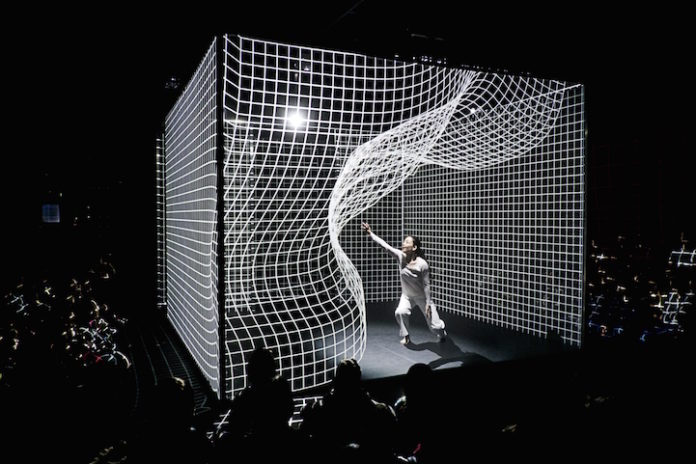The pendulum of a grandfather clock swings back and forth in a rhythm of equality and precision. The arc of swing is the same in both directions; no side claims more of the pendulum’s time in its domain. If only this model of equality and rhythmic precision could be duplicated in life’s larger debates. Art and the need for arts education is a topic which has found itself struggling with pendulum shifts regarding its importance. Academy of Art University in San Francisco knows this.
As the age of information has dawned, technology has taken an overwhelming lead in every aspect of life, education, and business. Progress pushes every discipline to adapt or be left in the primordial dust of a distant past. The liberal arts and artistic expression is often viewed as something of a bygone era before the digital age brought us maturity and precision. Sadly, this is why the pendulum seems to swing far to one side or the other without the necessary balance.
Art and technology are not two sides of the proverbial counterfeit coin, neither being of any value. Rather, they are complimentary ingredients that both add something flavorful to the overall recipe of mankind. Each have made invaluable contributions to our human world, and more are just over the horizon. A balanced view of art and technology, like the balanced pendulum of a grandfather clock, provides equal emphasis on both and reaps unparalleled rewards.
Why We Need Arts Education in a Digital Age
In order to thrive in our present environment, students need regular exposure to modern reality. This reality combines STEM (Science, Technology, Engineering, and Mathematics) with Art. Some of the greatest examples of creativity in our human story have been and continue to be engineers, scientists, and mathematicians who have reimagined, reinterpreted, and remade our world into its present form.
The dated and worn argument in favor of arts education that cites the need for promoting creativity suggests that math and science do not have any connections to creative thought or expression. This is nonsense and needs to be discarded. We need equal focus on arts education for profound and fundamentally human reasons. Art and the artists who create it in all forms help us explore life and the world in which we exist.
The importance of this cannot be overstated when one considers the new world in which we now live: for the first time in the history of mankind we are connected in one great cultural ecosystem. No longer do cultures stop at borders drawn on a map or globe. The defining differences among us are now shared across cultures without borders because of technology. People and cultures are linked.
And yet, the technology of computer hardware, routers, switches, and the internet, nor the most innovative software platforms shape how this great conglomeration of humanity views one another. The issues that concern us, our moods, the topics we discuss continue to be shaped and shared through the expression of human feelings. Think of how sweeping changes in the recent past were driven. It was primarily through the movies, novels, cartoons, songs, humor, and other forms of artistic expression.
Creativity and innovation occur when STEM and Art cross-pollinate, especially at universities like the Academy of Art University, and the most powerful examples of this are found in Silicon Valley.
- Facebook co-founder and CEO Mark Zuckerberg was a psychology major before dropping out of Harvard University, and he said Facebook is “as much psychology and sociology as it is technology.”
- Steve Jobs, co-founder and former CEO of Apple, credited a course in calligraphy for the font aesthetic of the Mac computer. When unveiling a new edition of the iPad, he said, “It is in Apple’s DNA that technology alone is not enough. Its technology married with liberal arts, married with the humanities, that yields us the result that makes our hearts sing.”
We have finally come to realize that combining STEM and Arts education (STEAM) produces well-rounded students and citizens who themselves are more humane people. It protects the cultural heritages of our world and enables us to understand the great creations that have shaped the growth of our world civilization.
Art Institutions Must Adapt to the Digital Age
According to the National Endowment for the Arts, attendance of live performances in 2015 fell slightly from 39% to 33%. One particular demographic actually grew in participation: older Americans. The same survey also found that the majority of Americans (71%) used some form of electronic media to watch, listen, or otherwise engage with the arts. This caused many art institutions to rethink their level of relevance in our modern culture. Notably, they will not continue to exist as the quiet temples of culture that once attracted older generations.
That also may pose difficulties for these institutions who depend on older generations of donors and supporters. However, to survive today and impact future generations, they must choose what to keep and what to change, striking the right balance between preservation and innovation for both new and old audiences.
Academy of Art University and institutions like it have learned to combine the power of digital technology with students’ own creative passions to feed interest-driven arts learning. Technology provides more pathways for students and creatives to collaborate, share, and publish their work with peers as well as with other interested parties.
Balancing Innovation and Tradition
How much innovation will audiences tolerate? This will vary widely depending on the institution. In a small step, many traditional art museums have made spaces for selfie-taking or having interactive tours via in-house iPads. New York’s Cooper Hewitt Smithsonian Design Museum underwent a $91 million digital renovation in 2011. New features included interactive pens that allow viewers to access exhibit information on touch-sensitive tables. There’s also an “immersion room,” which projects design samples like textiles or historic wallpaper with a tap of the pen.
“It’s really an experiential thing that’s about creating a memory,” said Micah Walter, Cooper Hewitt’s director of digital and emerging media. “We’ve tried to use technology to help our visitors stay in the moment.”
Traditionalists worry that something may be lost in that experimentation. Some argue this has already happened in pockets of pop culture like rock concerts, where more is often captured with a phone camera to be remembered later than enjoyed in the moment with the naked eye.
“Live performance is about finding our humanity — those common human elements without which technology is just a machine,” said Virginia Tech Theater and Arts Leadership professor Amanda Nelson. “If we forget about the human component, we’re losing something.”
Yet most say arts institutions like Academy of Art University have always changed to suit the masses. “Arts organizations always have to change to survive whether it’s to accommodate taste or whatever it may be as they learn more about their audience,” said Indiana University Lily School of Philanthropy professor Tim Seiler. When a balance is struck, innovation can enrich the traditional. A push toward digital is a doorway to introduce larger audiences to the arts.
Academy of Art University – Setting the Standard
Like the city it’s called home since 1929, Academy of Art University in San Francisco, California, claims it has always existed on the vanguard of innovation and creativity. In 1946 that took the form of Cartooning, Fashion Illustration, Advertising & Commercial Art, and Lettering & Layout. By 1951 innovation was expressed through a new department for Transportation Design. Today that same sense of creativity and innovation is found in several departments and degree programs that combine art and technology.
Following are just a few examples of fields of study offered at Academy of Art University.
Animation and Visual Effects
The university’s Animation and Visual Effects Department is one of the most dynamic Animation and VFX programs in the country. If you’re an aspiring storyboard artist, visual effects artist, 2D or 3D Animator, you can learn from some of today’s most accomplished professionals in the heart of the animation industry. The School of Animation & Visual Effects BFA program provides students with the skills necessary to master today’s digital technology. Students choose one primary area of emphasis between visual effects, 3D modeling, 3D animation, 2D animation and stop motion, and storyboarding.
Alumni Success Story
Jesse Witt & Ryan Bauer– Digital Artists, Cosa VFX
Jesse and Ryan have both worked on such notable projects as Person of Interest, Gotham, Agents of Shield, and Stranger Things.
“They taught me how to employ ideas in different ways. That is a much more important skill set than trying to learn any specific technical nuance.” – Jesse Witt, Academy class of 2015.
Communications and Media Technologies
A degree in Communications & Media Technologies opens the door to the future of media and entrepreneurship. Keep pace with an ever changing media landscape – from broadcast to streaming, from mobile to social. Multiplatform. Cutting edge. Hands-On. The School of Communications & Media Technologies BA program provides a dynamic education of essential modern media skills including foundations in storytelling, broadcasting, journalism, and mobile platforms. Under the guidance of industry experts, students learn to shoot, edit, write, and host their own productions, and use the latest technologies to stream and broadcast them.
Alumni Success Story
Kendall Long – Creative Director for WhoHaha which works with funny women and budding comedians both before and behind the camera. She has worked to design and craft sets on MTV’s Ridiculousness, Escape the Living Dead, TLC’s Dare to Wear, and Food Network’s Mystery Diners. She most recently appeared as a contestant on Season 22 of ABC’s The Bachelor.
Kendall is a 2014 graduate of Academy of Art University’s School of Communications and Media Technologies.
Music Production & Sound Design for Visual Media
Turn your appreciation of great music and sound into a brilliant career. Learn about harmony, orchestration, composition and scoring, as well as sound design, editing, and mixing techniques from industry professionals, and apply these skills in film and video game production. Join us today and take the first step toward this exciting and rapidly evolving field. The BFA program provides specialized training across many interdisciplinary aspects of music and sound design. Curriculum focuses on advanced music and sound production techniques, creating sound for video games, music notation, and film score preparation.
Alumni Success Story
Mark Cofer – Hollywood Film Composer
Mark’s credits in 2017 included composing music for hit films like Spiderman: Homecoming, The Magnificent Seven, and Independence Day: Resurgence.
“A class with Dirk Epperson was the single most influential class I’ve had,” says Cofer, referring to Associate Director, School of Music Production & Sound Design for Visual Media Dirk Epperson. “I learned a lot from Dirk and still use many of the principles I learned during his classes.” – Mark Cofer, Academy class of 2014.
Web Design and New Media
The School of Web Design & New Media prepares students for cutting-edge careers in experiential design and digital media. We teach an integrated approach based on four fundamentals: design thinking, visual communication, technology, and user experience. Our graduates are strategic thinkers, producers, and technologists poised to lead innovation on a global level. The BFA program provides students with a comprehensive education in the principles of modern web design and new media. Taught by a faculty that works in the San Francisco Bay Area creative industry, our students are provided a unique opportunity to learn from teachers immersed in the field. The curriculum focuses on visual design, user experience, design strategies, web design, and motion graphics.
Alumni Success Story
Terry Jones – Advertising Mogul and Academy of Art University Faculty
Terry’s numerous high-profile advertising clients include GMC Trucks, Buick and Cadillac, Bank of America, Hewlett-Packard, The Walt Disney Company, California Lottery, AARP, and General Mills. Terry now teaches classes at the academy in Advertising and Web Design and New Media.
“I had teachers who would take me aside and mentor me, and also had mentors throughout my career,” he says. “It wasn’t just about business, it was about life. And that’s the same way I try to teach now. You have to understand and be empathetic to different cultures, people and how they deal with things. There’s no one-size-fits-all way to teach.” – Terry Jones, Academy class of 1992.
Visual Development
Have you ever wondered how elaborate scenes and characters are imagined for movies or how fantastical worlds are realized in video games? That’s the job of the visual development artist. Study composition, perspective, environment design, figure drawing and character design—everything you’ll need to embark on a creatively rewarding visual development career. The School of Visual Development’s BFA program provides a dynamic education in the art of scene setting. Core curriculum emphasizes photography, figure modeling, form analysis, figure drawing, narrative principles, visual development for animation, character design, concept paintings, advanced exploration of perspective for video game design, and various other critical design disciplines.
Alumni Success Story
Daniel Arriaga – Senior Director, Pixar Animation Studios
Daniel’s latest credits include the 5-year journey to complete the recent animated blockbuster film Coco from Wald Disney Studios.
At a recent interview on the Academy campus, Daniel share, “This is a real dream come true to be back here at my school,” Arriaga said. “To be able to stand here is really the moment I can say ‘I made it.’” – Daniel Arriaga, Academy class of 2011.
Writing for Television, Film, and Digital Media
Tap into your imagination. Come up with great ideas. Find your unique voice. Take your writing skills to a new level. The BFA in Writing for Film, Television & Digital Media prepares aspiring writers to meet the creative and business challenges of the entertainment industry. By the time you graduate, you will have written two screenplays, three spec TV scripts, one pilot and three short film scripts. You will also work as a staff writer on two web series. So if your goal is to create a body of work that could launch your professional writing career, our program will give you the competitive edge you need.
Alumni Success Story
Vonti McRae – Project Management Team Lead, HBO
Vonti’s most recent credit includes work on the award-winning HBO series Game of Thrones. Vonti is a 2006 graduate of Academy of Art University.
Academy of Art University Students Combine Art and Technology to Benefit San Francisco
Recently, some Academy of Art University GAM students recently presented their work using augmented reality to the Chief Innovation Officer of the San Francisco Mayor’s Office of Civic Innovation. He toured the School of Game Development on November 28, 2017, to learn more about a new smartphone application called Tenderfeels. Their efforts, if adopted, will help make San Francisco’s renowned Tenderloin District safer for residents.
Although bordered by affluent neighborhoods like Nob Hill and Downtown, San Francisco’s Tenderloin district has been described as ‘unsafe,’ ‘disgusting,’ and ‘a zoo.’ Approximately 25,000 people live within the quarter-square mile area. The neighborhood has the highest rate of poverty and violent crime in the city while also housing the greatest concentration of youth.
The Tenderfeels application uses AR to harvest real-time data from Tenderloin residents as they share their moods relating to their current surroundings. A student on the team referenced the five emotional characters in the Pixar movie, “Inside Out.” Similar to these characters, residents using Tenderfeels can report in real time how they feel on each block within the Tenderloin district. The emotions range from ‘angry’ and ‘disgusted’ to ‘joyful’ and ‘happy.’
Other Tenderfeels app users can see the results in real time and see why a resident marked an area with a certain emotion. The overarching goal is to harvest this data and provide it to schools and government organizations who can use it to identify problem areas, with a view toward solving the issues revealed.
“It’s not Pokémon Go, but it’s actually taking on real-world, real life issues to try to make the city a better place. What’s done here can easily be extrapolated out to other cities,” said Steven Goodale, an instructor in the Academy’s School of Game Development.






